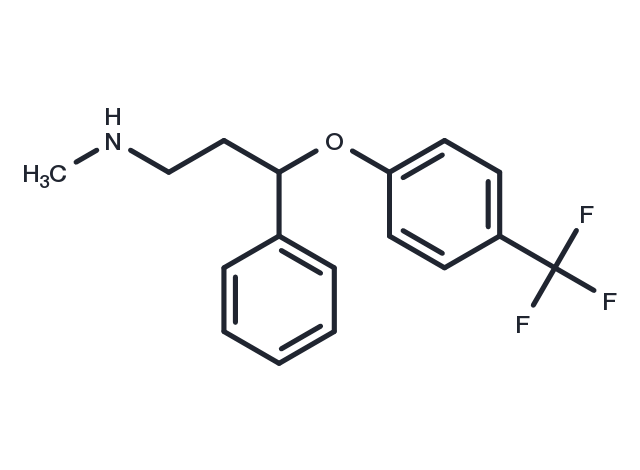Powder: -20°C for 3 years | In solvent: -80°C for 1 year
Fluoxetine (LY-110140) is a highly specific serotonin uptake inhibitor and selective 5-hydroxytryptamine (5-HT) reuptake inhibitor. Fluoxetine has antidepressant activity.

| パッケージサイズ | 在庫状況 | 単価(税別) | |||
|---|---|---|---|---|---|
| サンプルについてお問い合わせ | |||||
| 10 mg | 在庫あり | ¥ 7,000 | |||
| 25 mg | 在庫あり | ¥ 9,500 | |||
| 50 mg | 在庫あり | ¥ 13,000 | |||
| 100 mg | 在庫あり | ¥ 17,000 | |||
| 200 mg | 在庫あり | ¥ 28,500 | |||
| 500 mg | 在庫あり | ¥ 52,000 | |||
| 1 mL * 10 mM (in DMSO) | 在庫あり | ¥ 9,000 | |||
| 説明 | Fluoxetine (LY-110140) is a highly specific serotonin uptake inhibitor and selective 5-hydroxytryptamine (5-HT) reuptake inhibitor. Fluoxetine has antidepressant activity. |
| In vitro |
METHODS: Mouse cortical near-pure neuronal cell cultures were treated with Fluoxetine (3-30 µM) for 24 h. Cell viability was measured by MTT assay. RESULTS: Fluoxetine induced neuronal death in a concentration-dependent manner. [1] METHODS: Human gastric cancer cells AGS were treated with Fluoxetine (10-20 µM) for 24 h. Apoptosis was detected by Flow cytometry. RESULTS: The number of early apoptotic cells in Fluoxetine-treated group was significantly increased by about 4-fold and 10-fold, respectively. [2] |
| In vivo |
METHODS: To assay antidepressant activity in vivo, Fluoxetine (2.5-10 mg/kg) was administered intraperitoneally to MRL/MpJ mice twice daily for twenty-six days. RESULTS: Chronic treatment with 5 and 10 mg/kg Fluoxetine significantly increased cell proliferation and BDNF levels in the hippocampus. Only chronic treatment with the highest Fluoxetine increased BDNF levels in the frontal cortex. [3] METHODS: To test antidepressant activity in vivo, Fluoxetine (18 mg/kg) was administered orally once daily for three weeks to a model of corticosterone-induced anxiety/depression-like behavior in C57BL/6Ntac mice. RESULTS: Chronic Fluoxetine treatment reversed the anxiety phenotype. Regarding total distance traveled, chronic corticosterone treatment showed a nonsignificant trend that was eliminated by chronic Fluoxetine treatment. [4] |
| 別名 | LY-110140 |
| 分子量 | 309.33 |
| 分子式 | C17H18F3NO |
| CAS No. | 54910-89-3 |
Powder: -20°C for 3 years | In solvent: -80°C for 1 year
5% DMSO+95% Saline: 0.3 mg/mL (0.97 mM)
DMSO: 10 mg/mL (32.33 mM)
You can also refer to dose conversion for different animals. 詳細
bottom
Please see Inhibitor Handling Instructions for more frequently ask questions. Topics include: how to prepare stock solutions, how to store products, and cautions on cell-based assays & animal experiments, etc.
Fluoxetine 54910-89-3 Autophagy GPCR/G Protein Immunology/Inflammation Neuroscience Serotonin Transporter 5-HT Receptor MRP Inhibitor SERT LY 110140 inhibit 5-HTT SLC6A4 LY110140 LY-110140 inhibitor
